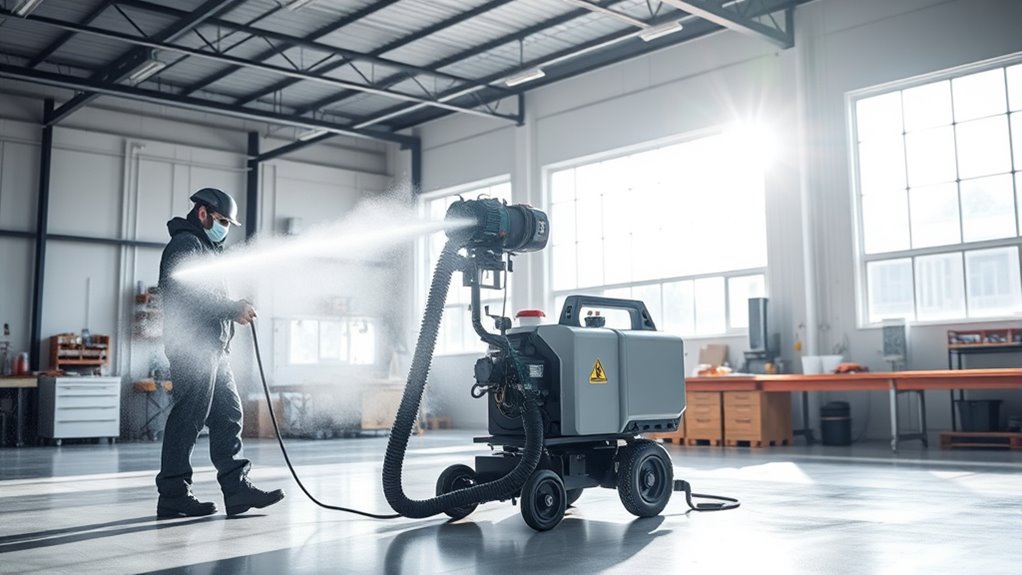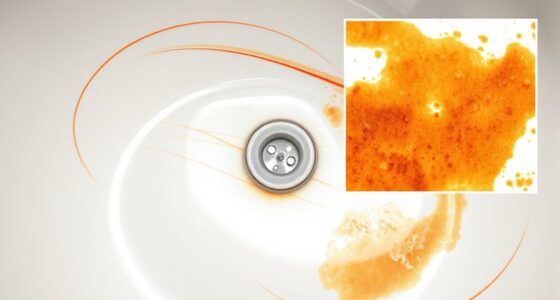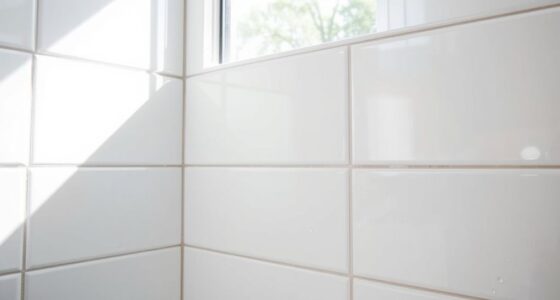To cut dust by 50% in one weekend, start by inspecting your space for dust hotspots and using monitors to track levels. declutter to eliminate traps, then use HEPA vacuums and microfiber cloths for thorough cleaning. Improve air quality with filters and proper ventilation. Establish daily routines like wiping surfaces, vacuuming, and keeping humidity low. Implementing these steps now will set you up for a cleaner environment—just keep going for even better results.
Key Takeaways
- Conduct a thorough dust assessment and monitor regularly to identify sources and high-traffic areas.
- Declutter spaces and store items properly to reduce dust traps and improve airflow.
- Use microfiber cloths, HEPA vacuums, and air purifiers to effectively remove dust from surfaces and the air.
- Improve ventilation with proper filters and maintain indoor humidity below 50% to inhibit dust buildup.
- Establish daily cleaning routines, such as wiping high-traffic areas and removing shoes, to prevent dust from settling.
Assessing Your Current Dust Situation
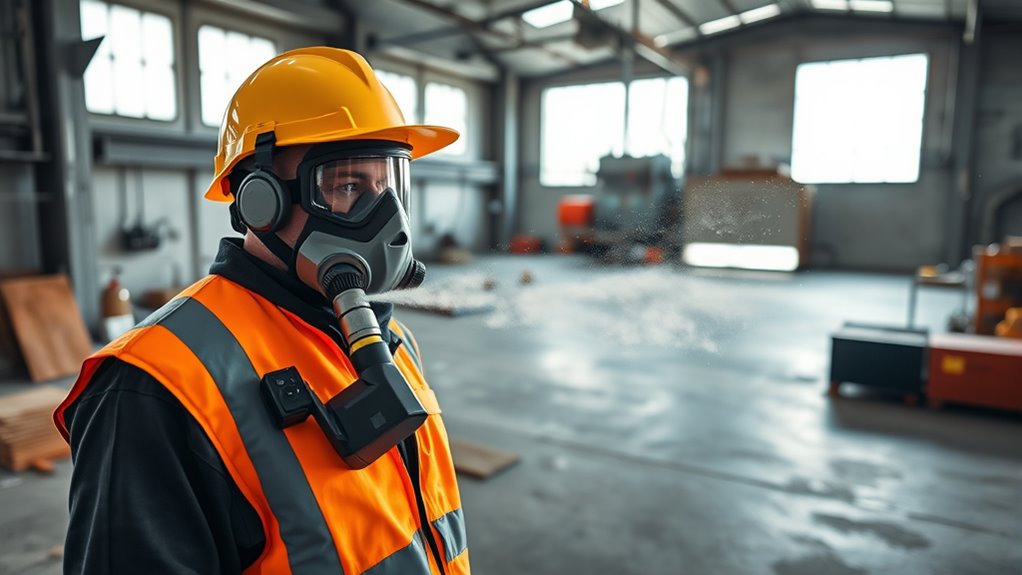
Before implementing dust control measures, you need a clear understanding of your current dust situation. Start by inspecting your space for dust buildup on surfaces, vents, and corners. Pay attention to areas prone to collecting dust, like under furniture or behind appliances. Use a dust meter or air quality monitor if possible; these tools help you gauge how much dust is circulating in your environment. Assess how often dust settles or becomes airborne, impacting your air quality. Keep track of visible dust and note areas with persistent buildup. Recognizing these patterns will help you identify sources of dust and prioritize where to focus your efforts. Understanding your current dust levels provides a solid foundation for effective, targeted dust control strategies. Additionally, awareness of air quality monitoring can help you make more informed decisions about your environment.
Clearing Clutter and Minimizing Dust Traps
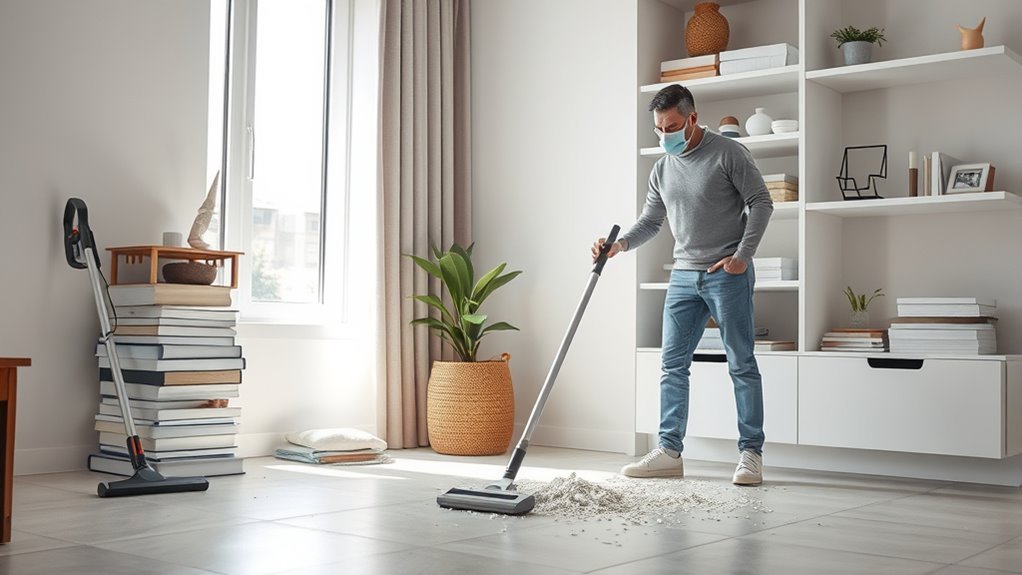
To reduce dust buildup, start by decluttering your workspaces and removing unnecessary items. Properly storing tools and materials prevents dust from collecting in hard-to-clean areas. Keeping things organized makes dust control more effective and your workspace safer. Additionally, understanding the importance of regulatory frameworks can help ensure you follow best practices for maintaining a dust-free environment.
Declutter Workspaces Effectively
Clearing clutter from your workspace is a crucial step in reducing dust buildup and improving air quality. When your space is organized, dust has fewer surfaces to settle on, making cleaning easier and more effective. Use clutter organization techniques to categorize items and eliminate unnecessary objects. Implement smart storage solutions like bins, shelves, or drawer organizers to keep items off desks and floors. The goal is to create a clean, open environment that minimizes dust traps. Regularly assess your workspace for clutter and dispose of or donate items you no longer need. Additionally, maintaining good air quality practices, such as using air purifiers and proper ventilation, can significantly enhance dust control efforts. By maintaining an organized space, you’ll not only cut down on dust accumulation but also boost your productivity. Staying consistent with clutter organization and storage solutions helps keep your workspace cleaner and healthier long-term.
Store Items Properly
Have you considered how properly storing items can drastically reduce dust buildup? Effective storage organization keeps clutter off surfaces and minimizes dust traps. Use sealed bins and cabinets to contain dust and prevent it from becoming airborne. Regular inventory management helps identify what you truly need, reducing unnecessary items that collect dust. Label boxes clearly, so you can quickly access items without rummaging through clutter. Keep seldom-used items in closed storage spaces, not open shelves, to prevent dust from settling. By maintaining an organized storage system, you reduce surfaces where dust can accumulate, making cleaning easier and more effective. Incorporating body awareness techniques can also help you stay mindful of areas prone to dust accumulation and improve your cleaning routines. Streamlining your inventory management and storage organization not only cuts dust but also creates a cleaner, healthier environment.
Choosing the Right Cleaning Tools and Products
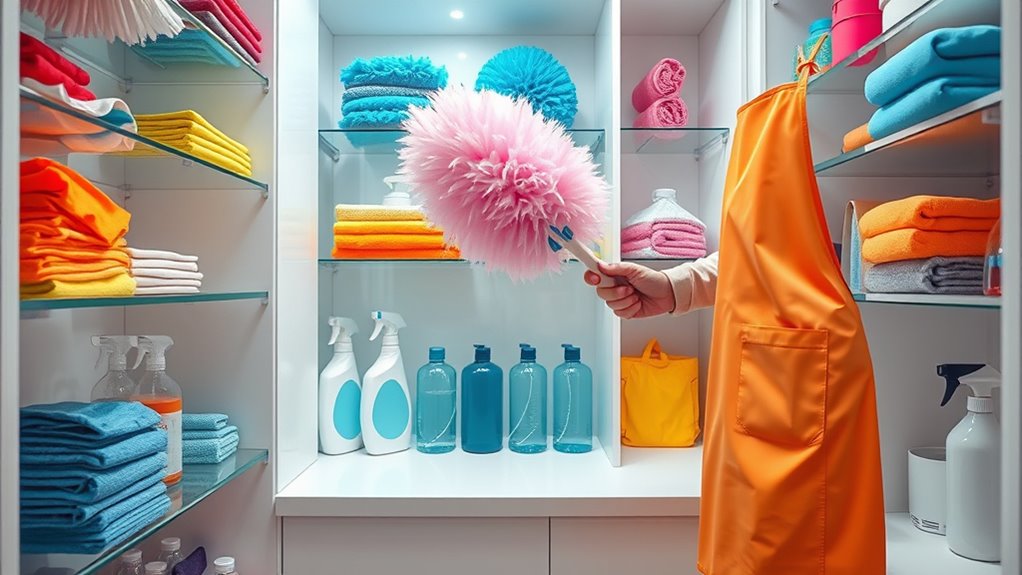
Are you selecting the best tools and products to keep dust under control? Start by choosing a vacuum with the right attachments, like crevice tools and upholstery brushes, to target hard-to-reach spots and soft surfaces. Using the correct vacuum attachments guarantees you lift dust effectively without spreading it around. Pair your vacuuming with effective cleaning solutions designed to trap dust and allergens, rather than just move them around. Look for products labeled for dust removal and hypoallergenic properties. Avoid harsh chemicals that can stir up dust or irritate your respiratory system. Investing in quality tools and suitable cleaning solutions makes a significant difference in reducing dust levels and maintaining a cleaner, healthier space. Incorporating color accuracy into your cleaning routine can also help you spot dust and dirt more effectively, ensuring a thorough clean.
Implementing Effective Dusting Techniques

To effectively reduce dust, it’s essential to adopt proper dusting techniques that trap particles rather than just spread them around. Proper methods focus on dust absorption and preventing airborne particles from settling elsewhere. Here’s what you should do:
Effective dust reduction relies on trapping particles with proper dusting techniques rather than spreading them around.
- Use microfiber cloths or dusters that attract dust instead of pushing it around.
- Dust from top to bottom to prevent recontamination of cleaned areas.
- Lightly dampen cloths to improve dust absorption and trap airborne particles.
- Always clean surfaces thoroughly, ensuring dust is captured and removed rather than dispersed into the air.
- Incorporate essential oils for respiratory health, such as eucalyptus or lavender, into your cleaning routine to help soothe the respiratory system and reduce airborne irritants.
Enhancing Air Quality With Ventilation and Air Purifiers

Wondering how to markedly improve indoor air quality? Start by using air quality monitoring devices to identify pollutant levels. Once you know where dust and allergens are concentrated, upgrade your ventilation system to enhance airflow and filtration. Installing high-efficiency filters or HEPA air purifiers helps trap airborne dust particles, reducing their circulation. Proper ventilation ensures stale air is replaced with fresh air, diluting indoor pollutants. Regularly monitoring air quality allows you to track improvements and adjust your approach if needed. Upgrading your ventilation system isn’t just about comfort; it’s a vital step in creating a healthier environment. Additionally, understanding AI Security vulnerabilities can inform smarter choices in home automation and security systems. With these measures, you’ll cut dust buildup and improve air quality, making your space cleaner and safer in just a weekend.
Establishing a Regular Dusting and Cleaning Schedule

Setting up a regular dusting and cleaning schedule keeps dust levels under control and improves air quality. You should stick to consistent routines and perform scheduled dust checks to catch problem areas early. This way, maintaining a cleaner environment becomes easier and more effective. Incorporating vertical storage solutions can also help reduce dust accumulation on surfaces and in hard-to-reach spots.
Consistent Cleaning Routines
Establishing a consistent cleaning routine is essential for effectively controlling dust buildup. Regular cleaning helps maintain a dust barrier that keeps particles from spreading. To stay on top of dust, follow these steps:
- Set a cleaning frequency—daily or weekly—based on your home’s needs.
- Dust surfaces, including furniture and vents, to prevent dust from settling.
- Vacuum carpets and upholstery thoroughly to remove embedded particles.
- Wipe down high-traffic areas to reduce dust circulation.
- Incorporate protective styling methods, such as crochet styles for locs, to minimize dust accumulation on hair and scalp.
Sticking to this routine minimizes dust accumulation and improves indoor air quality. Consistency ensures that dust doesn’t get a chance to build up, making your cleaning efforts more effective. Remember, a well-maintained dust barrier starts with regular, disciplined cleaning.
Scheduled Dust Checks
How often should you check for dust to keep your home consistently clean? Regular dust checks help you identify problem spots and maintain a dust-free environment. Use a dust sensor or your senses to spot buildup, especially in high-traffic areas. Schedule dusting sessions weekly or biweekly, focusing on overlooked surfaces. Selecting the right vacuum is essential—choose one with strong suction and a good filter for effective dust removal. Consider models with advanced vacuum selection features that adapt to different surfaces. Here’s a quick guide:
| Dust Check Frequency | Recommended Tools |
|---|---|
| Weekly | Vacuum with dust sensor |
| Biweekly | Microfiber cloths |
| Monthly | HEPA-filter vacuum |
Stick to this schedule, and you’ll cut dust by 50% faster. Regularly checking and maintaining your grocery store hours can also help you plan cleaning supplies shopping trips more efficiently.
Tips for Maintaining a Dust-Free Environment

To effectively maintain a dust-free environment, you need to implement consistent cleaning routines and control dust sources at their origin. Focus on dust mite prevention and allergen reduction by:
- Regularly washing bedding, curtains, and soft furnishings to eliminate dust mites.
- Using high-efficiency particulate air (HEPA) filters in your HVAC system to trap airborne allergens.
- Sweeping and vacuuming with a HEPA-equipped vacuum to remove dust from floors and carpets.
- Keeping humidity levels below 50% to inhibit dust mite growth and reduce allergen buildup.
- Incorporating AI-powered cleaning devices that can monitor and optimize your cleaning routines for better dust control.
These steps help prevent dust accumulation at the source, making it easier to sustain a cleaner, healthier space. Consistency is key to long-term dust control and allergen reduction.
Monitoring Progress and Adjusting Your Approach

Tracking your progress is essential to guarantee your dust control strategies are effective. Regular progress tracking helps you see what’s working and identify areas needing improvement. Use simple tools like checklists, photos, or dust level measurements to monitor changes over time. If you notice dust levels aren’t decreasing as expected, it’s time to contemplate adjustment strategies. For example, you might increase ventilation, enhance cleaning frequency, or add barriers. Flexibility is key—don’t hesitate to tweak your approach based on the data you collect. Consistent monitoring keeps you on course and ensures your efforts lead to a cleaner, healthier environment. Remember, small adjustments can make a significant difference in achieving your dust reduction goals. Incorporating maintenance schedules can help keep dust levels consistently low over the long term.
Frequently Asked Questions
What Are Common Mistakes to Avoid During Dust Control?
You should avoid neglecting proper ventilation strategies, as poor airflow can worsen dust issues. Don’t overlook equipment maintenance, which ensures dust suppression systems work effectively. Also, avoid rushing dust control measures; rushing can lead to missed spots and ineffective results. Regularly inspect and adjust your setup, keep vents clear, and maintain equipment to prevent dust from spreading. These steps help you achieve cleaner, safer environments efficiently.
How Can I Identify Hidden Dust Hotspots?
To identify hidden dust hotspots, start with dust sampling in less obvious areas like behind equipment or inside ventilation ducts. Conduct airflow analysis to spot areas with poor circulation where dust can settle. Pay attention to corners, cracks, and concealed surfaces, and use handheld detectors for real-time dust detection. Regular inspections combined with these methods help reveal hidden hotspots, enabling you to target cleaning and dust control efforts effectively.
What Budget Options Are Available for Dust Reduction?
You don’t need a big budget to reduce dust effectively. Cost-effective solutions like installing simple barriers, using wet methods, or upgrading ventilation can be budget-friendly options. These measures, though affordable, drastically cut dust levels and improve safety. By prioritizing budget-friendly options, you can implement immediate dust control strategies without overspending, making your workplace cleaner and safer while keeping costs manageable.
How Long Does a Typical Dust Control Overhaul Take?
A typical dust control overhaul takes about one to two days, depending on your facility size. You’ll start with air filtration upgrades and dust monitoring systems to identify problem areas. Then, you’ll install or improve ventilation and dust suppression methods. Regular checks during the process ensure everything’s working efficiently. With proper planning, you can substantially reduce dust levels quickly, making your workspace safer and cleaner.
Can DIY Methods Match Professional Dust Control Effectiveness?
DIY solutions can come close to matching professional standards if you follow proven techniques and use quality materials. You’ll need to invest time and effort, but proper sealing, regular cleaning, and installing dust barriers can markedly reduce dust. While professionals have advanced equipment, consistent application of effective DIY methods can achieve substantial dust control, making your space safer and cleaner without the high costs of professional services.
Conclusion
By evaluating your dust, clearing clutter, choosing the right tools, implementing effective techniques, and maintaining a routine, you take control of your environment. You breathe easier, feel fresher, and enjoy a healthier space. You reduce dust, eliminate allergens, and create comfort. You commit to cleanliness, embrace consistency, and see results. You transform your home into a cleaner, safer haven—one weekend at a time. Take action today and experience the difference tomorrow.
